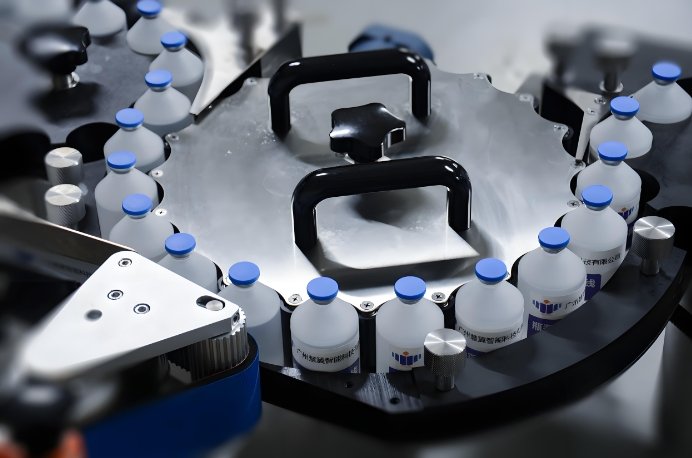
In today’s fast-paced manufacturing world, automation is more than just a trend—it’s a necessity. A modern Labeling Machine with a PLC (Programmable Logic Controller) control system is a smart investment that offers unmatched speed, precision, and control. When paired with an Automatic Filling Machine, this combination creates a seamless, highly efficient packaging line.
Let’s explore how a PLC-controlled Labeling Machine works, why it’s superior to conventional systems, and how it integrates perfectly with your existing Automatic Filling Machine.
What Is a PLC-Controlled Labeling Machine?
A Labeling Machine with a PLC control system is equipped with a programmable digital computer designed specifically for industrial applications. This controller manages the entire labeling process—timing, sensor inputs, label feed, and placement accuracy.
Unlike mechanical timers or basic electronic circuits, a PLC is far more flexible and reliable. It can be reprogrammed as needed, offers real-time feedback, and supports communication with other machines like your Automatic Filling Machine.
Key Advantages of PLC Integration
✅ Precise Label Placement
With a PLC, the Labeling Machine responds instantly to sensor data. It knows the exact location of each container and adjusts label application in real-time. This precision is especially crucial for high-speed lines that work with different bottle shapes.
✅ Full Synchronization with Automatic Filling Machine
A PLC allows your Labeling Machine to be synchronized perfectly with your Automatic Filling Machine. As filled containers exit the filler, the labeling cycle starts automatically. This eliminates jams, misfeeds, and downtime.
✅ Easy Recipe Changes
Need to switch from a 500ml bottle to a 1L container? No problem. With a PLC, you can load saved settings with a single button. It adjusts conveyor speed, label length, and sensor delays without needing manual tweaks.
✅ Reduced Human Error
The automated nature of a PLC-controlled Labeling Machine means less manual intervention. That results in fewer mistakes, less waste, and consistent results every time.
How It Works with an Automatic Filling Machine
The integration between your Labeling Machine and Automatic Filling Machine is critical for efficiency. Here’s a step-by-step breakdown:
- Filling Stage: The Automatic Filling Machine fills containers with product. It may also cap or seal them depending on your setup.
- Signal Communication: The PLC in the Labeling Machine receives signals from the filling unit, confirming that a container is ready.
- Label Application: The Labeling Machine instantly applies the label in the correct position as the bottle passes.
- Data Feedback: Sensors detect label presence, print code accuracy, and container alignment. The PLC adjusts operations if any errors occur.
This intelligent communication results in smooth, uninterrupted labeling, even at high speeds.
Features of a PLC-Controlled Labeling Machine
When shopping for a Labeling Machine with a PLC system, look for these must-have features:
✔️ Touchscreen HMI
A human-machine interface (HMI) allows operators to monitor performance, set configurations, and troubleshoot with ease.
✔️ Multiple Sensor Support
Whether you’re using optical sensors for clear labels or mechanical switches for odd-shaped containers, the PLC supports a wide variety.
✔️ Alarm & Fault Detection
PLC logic enables real-time monitoring. If a label is missing or misaligned, the system alerts the operator and stops the line.
✔️ Ethernet/Modbus Communication
For advanced factories, the PLC can link with central systems or MES (Manufacturing Execution Systems) for total line control.
✔️ Recipe Memory
This feature allows you to save multiple product settings. Switching between product types becomes quick and simple.
Ideal Industries for PLC-Controlled Labeling
A Labeling Machine with PLC is suitable across multiple industries:
- Food & Beverage: Pair with an Automatic Filling Machine for juice, milk, or sauces.
- Pharmaceuticals: Perfect for accurate labeling on small vials and bottles.
- Cosmetics: Apply front-and-back labels with high precision on lotion bottles.
- Chemical Products: Handle corrosive or heavy-duty cleaning bottles with ease.
- Nutraceuticals: Label and code supplement containers on the same line.
Whether you need fast labeling for thousands of units per hour or intricate control for high-value products, PLC systems deliver.
Custom Integration with Your Filling Line
When connecting your Labeling Machine to your Automatic Filling Machine, consider:
- Speed Matching: The PLC must match conveyor speeds and product timing.
- Bottleneck Prevention: Use sensors to ensure bottles don’t jam between machines.
- Modular Layout: Your Labeling Machine should be adjustable and movable for flexibility in your production space.
- Central Control Panel: Some systems allow you to manage both filling and labeling through one HMI panel.
These steps ensure a seamless, efficient operation with fewer delays and less operator involvement.
Long-Term ROI and Maintenance
💰 Cost Savings
Though PLC-controlled machines may cost more upfront, they offer lower maintenance costs, better performance, and fewer errors. Over time, the return on investment is substantial.
🧼 Easy Maintenance
PLCs include diagnostics and fault logs. Maintenance teams can quickly identify problems and fix them without trial and error.
🔧 Upgradable
As your line evolves, you can update the PLC programming. There’s no need to replace the entire Labeling Machine—just adjust the logic or hardware as needed.
Final Thoughts
Adding a Labeling Machine with a PLC control system is a smart way to increase productivity, reduce waste, and improve product quality. When integrated with an Automatic Filling Machine, it creates a highly automated packaging solution ideal for modern factories.
From real-time monitoring to recipe management and seamless communication, PLC systems deliver powerful benefits that traditional machines cannot match. They adapt quickly, run reliably, and ensure every product is labeled perfectly.

